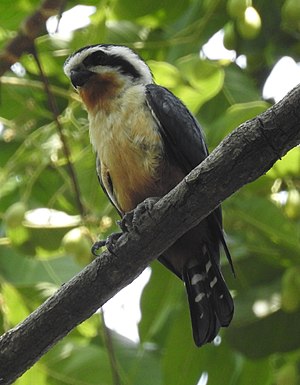European robin falcon
| European robin falcon | ||||||||||||
|---|---|---|---|---|---|---|---|---|---|---|---|---|

European robin ( Microhierax caerulescens ) |
||||||||||||
| Systematics | ||||||||||||
|
||||||||||||
| Scientific name | ||||||||||||
| Microhierax caerulescens | ||||||||||||
| ( Linnaeus , 1758) |
The European robin falcon ( Microhierax caerulescens , Syn .: Falco caerulescens ) is a bird of the falcon-like family (Falconidae).
The bird is found on the Indian subcontinent and in Southeast Asia in Bangladesh , Bhutan , India , Cambodia , Laos , Malaysia , Myanmar , Nepal , Thailand and Vietnam .
The range includes forests of temperate zones , often edges of deciduous forests , also plantations and near rivers.
description
The robin falcon is 14-18 cm tall, weighs between 30 and 50 g, the wingspan is 28-34 cm. The female is larger and heavier than the male. In size and behavior with relatively short wings and tail of medium length black with four white bands that Rotkehlfälkchen reminiscent of a strangler . The wide white neck band is striking. The top is glossy black, forehead, ear covers and neck are white, the face has a black mask, the wax skin is also black. The underside is rust-red and white, the neck, lower abdomen and partially feathered thighs and the underside of the tail are dark red-brown. When young, the bird is light with a red-brown head.
Geographic variation
The following subspecies are recognized:
- M. c. caerulescens ( Linnaeus , 1758), nominate form - eastern Himalayas from Uttarakhand and Nepal to northeast India
- M. c. burmanicus Swann , 1920 - Myanmar east to Indochina
voice
The male's call is described as a high-pitched "kli-kli-kli ..." or "killi-killi-killi ...".
Way of life
The diet consists mainly of large insects , especially butterflies as Julia Butterfly and swallowtail butterfly or dragonfly and beetle , also from smaller birds or locusts . The European robin does not hunt from a fixed hide, but moves quickly from one tree to another.
The breeding season is between late February and May. Nests are popular in caves created by a Ceylon green-bearded bird ( Megalaima zeylanica ) or a line woodpecker ( Dryocopus lineatus ) at a height of 10 to 12 m and often on the underside of a bare branch. The clutch consists of 4 white eggs with markings. Both sexes participate in the breeding business.
The flight is reminiscent of a gray tern star ( Artamus fuscus ), the head is jerked on a hide looking in all directions like a Brahma owl .
Hazardous situation
The stock is not considered to be at risk ( least concern ).
Web links
- Videos, photos and sound recordings for Microhierax caerulescens in the Internet Bird Collection
- Oiseaux.net
Individual evidence
- ↑ Rotkehlfälkchen , in Avibase - The World Bird Database
- ↑ a b c d e Handbook of the Birds of the World
- ^ A b S. Ali: The Book of Indian Birds. Bombay Natural History Society, Oxford university Press, 13th ed. 2002, ISBN 978-0-19-566523-9
- ↑ a b animal documentation
- ^ IOC World Bird List Seriemas, falcons
- ↑ Redlist
